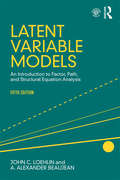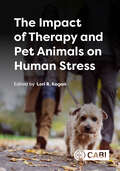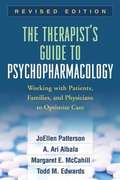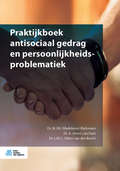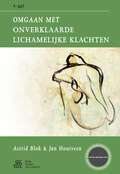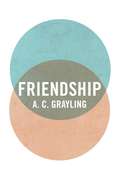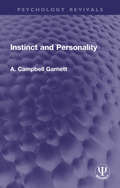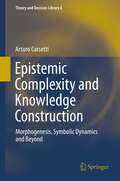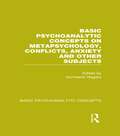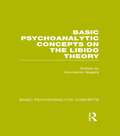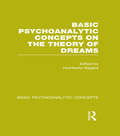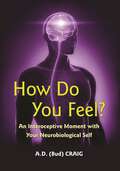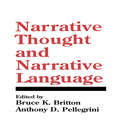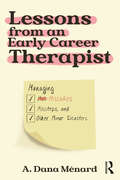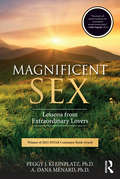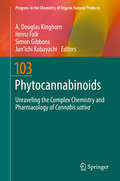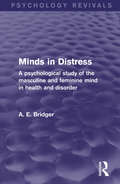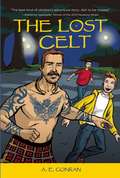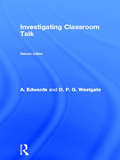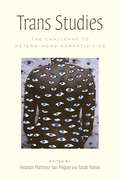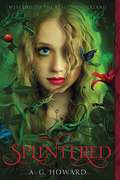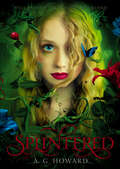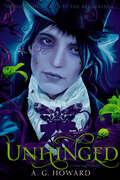- Table View
- List View
Latent Variable Models: An Introduction to Factor, Path, and Structural Equation Analysis, Fifth Edition
by A. Alexander Beaujean John C. LoehlinLatent Variable Models: An Introduction to Factor, Path, and Structural Equation Analysis introduces latent variable models by utilizing path diagrams to explain the relationships in the models. This approach helps less mathematically-inclined readers to grasp the underlying relations among path analysis, factor analysis, and structural equation modeling, and to set up and carry out such analyses. This revised and expanded fifth edition again contains key chapters on path analysis, structural equation models, and exploratory factor analysis. In addition, it contains new material on composite reliability, models with categorical data, the minimum average partial procedure, bi-factor models, and communicating about latent variable models. The informal writing style and the numerous illustrative examples make the book accessible to readers of varying backgrounds. Notes at the end of each chapter expand the discussion and provide additional technical detail and references. Moreover, most chapters contain an extended example in which the authors work through one of the chapter’s examples in detail to aid readers in conducting similar analyses with their own data. The book and accompanying website provide all of the data for the book’s examples as well as syntax from latent variable programs so readers can replicate the analyses. The book can be used with any of a variety of computer programs, but special attention is paid to LISREL and R. An important resource for advanced students and researchers in numerous disciplines in the behavioral sciences, education, business, and health sciences, Latent Variable Models is a practical and readable reference for those seeking to understand or conduct an analysis using latent variables.
The Impact of Therapy and Pet Animals on Human Stress
by Paul J. Zak A. Alexander Beaujean Jeffrey R. Stevens John-Tyler Binfet Roger N. Reeb Brianne Donaldson David M. Feldman Aliya Khalid Abigail Alfrey Ariann E. Robino Alyssa N. Stein Melody A. Schmaltz Hailey A. Fitzpatrick Jaime L. Tartar Frankie Pizzo Marah Friedman Olivia Feldman Rafael Martos-Montes David Ordóñez-Pérez Jesús Ruiz-Maatallah Miriam Martínez-Cobos Elise R. Thayer Jonathan B. Banks Caitlin McCoy Courtney Trzcinski Nicole L. Beasley Greg C. Elvers Hannah L. Torok Patricia Pendry Alexa M. Carr Stephanie M. Roeter Jaymie L. Vandagriff Saadia Dildar Benjamin A. Curry Moana Vercoe Matthew Filippo Karen Manville Mark Coulson Michele A. Mulqueen Kirsty Neller Caroline Searing Sarah Welland Gemma Reynolds Freya L.L. Green Rebecca J.P. Godard Madisyn M. Szypula Camille X. Rousseau Jordy Decker Beth A. Lanning Amelia L. Wilson Robert Woelk Lauren Highfill Miranda Goodman-Wilson Mónica Teresa González-Ramírez René Landero-Hernández Minerva Vanegas-FarfanoStress can have a deleterious effect on people's mental, physical, and psychological health. There is a growing body of evidence, however, that suggests animals, both as pets and therapy partners, can help mitigate people's stress levels. This book showcases a rich collection of research papers from Human-Animal Interactions. It highlights research pertaining to pets as well as animal-assisted therapy in both school and professional settings. The book also includes a scene-setting introduction and wrap-up conclusion from the editor. Providing comprehensive information on the impact of animals on human stress, this book is a useful resource for anyone interested in human health or human-animal relationships.
Therapist's Guide to Psychopharmacology, Revised Edition
by Joellen Patterson A. Ari AlbalaThis indispensable book provides therapists and counselors with crucial knowledge about psychotropic medications when and how to make medication referrals, how to answer patients' questions and help them handle problems that arise, and how to combine medication and psychotherapy effectively. Ideal for readers without extensive background in neurobiology, the book clearly explains how medications work in the brain and how they affect an individual's emotions, behavior, and relationships. Strategies for collaborating successfully with patients, their family members, and prescribers are discussed in detail. In this edition, psychopharmacology content has been fully updated.
Praktijkboek antisociaal gedrag en persoonlijkheidsproblematiek
by M. J. N. Madeleine Rijckmans A. Arno Van Dam L. M. C. Wies Van Den BoschBehandelaren in de GGZ worden in toenemende mate geconfronteerd met mensen met antisociale problematiek. Dit praktijkboek geeft handvatten voor de behandeling van mensen met antisociaal gedrag voortkomend uit persoonlijkheidsproblematiek. De handvatten zijn gebaseerd op wetenschappelijke kennis en best practices. Het boek is bedoeld voor psychologen, psychiaters, maatschappelijk werkenden en (sociaalpsychiatrisch) verpleegkundigen werkzaam binnen de reguliere en forensische GGZ. Praktijkboek antisociaal gedrag en persoonlijkheidsproblematiek laat aan de hand van praktijkvoorbeelden zien hoe de behandelaar kan omgaan met specifieke behandelsituaties en hulpvragen als agressie, middelengebruik en suïcidaliteit. Daarnaast beschrijft het boek methodes om cliënten en hun sociale omgeving te helpen het antisociale gedrag te veranderen of er beter mee om te gaan. Ook wordt er aandacht besteed aan de emoties die deze cliënten oproepen bij behandelaren en aan de vraag hoe behandelaren hier effectief mee om kunnen gaan. Het eerste deel beschrijft argumenten voor en tegen het behandelen van mensen met antisociaal gedrag of antisociale persoonlijkheidsproblematiek. Daarna worden de mogelijkheden van het doen van diagnostiek en risicotaxatie binnen de reguliere GGZ beschreven en wordt stilgestaan bij het belang van de therapeutische relatie. Vervolgens worden theorieën en technieken beschreven om de doelgroep te motiveren voor behandeling. In het tweede deel staan de meer specifieke problematieken van de doelgroep centraal, zoals het voorkomen en behandelen van agressie, omgaan met verslavingsproblematiek en suïcidaliteit. Het derde deel beschrijft specifieke behandelmethodieken, waaronder Dialectische gedragstherapie, de forensische variant van Schemagerichte therapie, Farmacotherapie, Systeemtherapie en een meer outreachende benadering. Praktijkboek antisociaal gedrag en persoonlijkheidsproblematiek is geschreven onder redactie van Dr. Madeleine Rijckmans, Dr. Arno van Dam en Dr. Wies van den Bosch. Zij werken alle drie als behandelaar in de klinische (forensische) praktijk en doen wetenschappelijk onderzoek. Ook zijn ze lid van het internationaal Podium Antisociaal Gedrag van waaruit ze proberen de behandelpraktijk voor deze doelgroep te verbeteren.
Omgaan met onverklaarde lichamelijke klachten
by A. Blok J. HoutveenInformatief boek voor mensen met onverklaarde lichamelijke klachten.
Friendship
by A. C. GraylingA central bond, a cherished value, a unique relationship, a profound human need, a type of love. What is the nature of friendship, and what is its significance in our lives? How has friendship changed since the ancient Greeks began to analyze it, and how has modern technology altered its very definition? In this fascinating exploration of friendship through the ages, one of the most thought-provoking philosophers of our time tracks historical ideas of friendship, gathers a diversity of friendship stories from the annals of myth and literature, and provides unexpected insights into our friends, ourselves, and the role of friendships in an ethical life. A. C. Grayling roves the rich traditions of friendship in literature, culture, art, and philosophy, bringing into his discussion familiar pairs as well as unfamiliar--Achilles and Patroclus, David and Jonathan, Coleridge and Wordsworth, Huck Finn and Jim. Grayling lays out major philosophical interpretations of friendship, then offers his own take, drawing on personal experiences and an acute awareness of vast cultural shifts that have occurred. With penetrating insight he addresses internet-based friendship, contemporary mixed gender friendships, how friendships may supersede family relationships, ones duty within friendship, the idea of friendship to humanity, and many other topics of universal interest.
Instinct and Personality (Psychology Revivals)
by A. Campbell GarnettOriginally published in 1928, the principle aim of this book was to present and apply an original viewpoint in psychology. The work is substantially that of a thesis on "The Problem of Personality in the Light of Recent Psychology" for which the author was awarded the degree of Doctor of Letters in the University of Melbourne in 1925. Today it can be read and enjoyed in its historical context.
Epistemic Complexity and Knowledge Construction
by A. CarsettiThe volume as its first target aims at clarifying that peculiar entanglement of complexity, causality, meaning, emergence and intentionality that characterises the unfolding of the "natural forms" of human cognition As is well known, cognition is not only a self-organising process. It is also a co-operative and coupled process. If we consider the external environment as a complex, multiple and stratified Source which interacts with the nervous system, we can easily realise that the cognitive activities devoted to the "intelligent" search for the depth information living in the Source, may determine the very change of the complexity conditions according to which the Source progressively expresses its "wild" action. In this sense, simulation models are not neutral or purely speculative: the true cognition actually appears to be necessarily connected with successful forms of reading, those forms, in particular, that permit a specific coherent unfolding of the deep information content of the Source. Therefore, the simulation models, if valid, materialise as "creative" channels, i.e., as autonomous functional systems, as the very roots of a new possible development of the entire system represented by mind and its Reality. From a general point of view, the objectivity of Reality is also proportionate to the autonomy reached by cognitive processes. In this sense, at the level of cultural evolution, reference procedures act as guide, mirror and canalisation with respect to primary information flows and involved selective forces: they offer themselves as the actual instruments for the constant renewal of the code, for the invention and the actual articulation of an ever-new incompressibility. From an effective point of view, they appear as indissolubly linked to the successive definition of specific (and innovative) measures of the epistemic complexity. These measures cannot concern only statistical rarity (Shannon) or computational incompressibility (Kolmogorov-Chaitin), on the contrary they should also be able to take into account the coupled connection between the Source and the cognitive agent, the evolution of this connection as well as the successive constitution of meaning as symbolic form. Hence the possible (and necessary) definition of new axiomatic systems, new measure spaces, the real displaying of processes of continuous reorganisation at the semantic level. Indeed, it is only through a complete, first-order "reduction" and a correlated non-standard second-order analysis that new incompressibility will actually manifest itself. Therefore, the reference procedures appear to be related to a process of multiplication of minds, as well as to a process of "clarification" of meanings which finally emerges as vision via principles.
Learning, 5th Edition
by A. Charles CataniaThe 5th Edition surveys the major areas in the psychology of learning from a consistent behavioral point of view. Learning explores the continuities between human learning and the learning of other animals. The book organizes the phenomena of learning in a systematic way, moving from Behavior Without Learning (evolution) to Learning Without Words (basics in nonhuman behavior and learning) to Learning With Words (human learning and memory).
The ABCs of Behavior Analysis: An Introduction to Learning and Behavior
by A. Charles CataniaThis new, undergraduate version of Catania’s Learning maintains the coherent treatment of animal and human learning that has been the hallmark of earlier versions. This new book has been tightened and reorganized, especially for undergraduate use and for use with students new to behavior analysis. Along with chapters on positive and negative reinforcement, operant classes, stimulus control, motivating operations, and basic schedules of reinforcement, it includes new chapters on sensory systems and on applied behavior analysis. <p><p>The general structure of this new version highlights the basic concepts of behavior analysis and demonstrates their relevance to a wide range of issues with concrete human examples and relevant narratives. It discusses widespread misconceptions about reinforcement; it outlines and updates the rationale for preferring free or noncontingent reinforcement over extinction as an instrument of behavior change; and it relates discrimination as a technical term to discrimination as it occurs in society while using the distinction between discrimination and prejudice to contrast the effects of direct social contingencies with those brought about by verbal shaping and verbal governance. <p><p>Other topics given special attention are higher-order classes, equivalence classes, sources of novel behavior, and self-awareness. Selection by consequences remains a unifying theme, and the roots of verbal behavior are shown to grow out of basic nonverbal behavioral processes. Its coverage of relevant research is supplemented by discussions of implications for ethics, politics, and cultural practices. The ABCs of Behavior Analysis is not a psychology book. It is truly a behavior analysis book. It is about how behavior works and its emphasis is on behavior analysis as a science in its own right.
Basic Psychoanalytic Concepts on Metapsychology, Conflicts, Anxiety and Other Subjects (Basic Psychoanalytic Concepts)
by Humberto Nagera A. Colonna E. First A. Gavshon A. Holder E. Dansky L. Kearney P. RadfordOriginally published in 1970 and in contrast to the previous three volumes, which each dealt with a single subject, this volume is a miscellaneous one. Seventeen subjects were selected on the basis of their relevance for the understanding both of psychoanalytic theory and of human behaviour in general. In this volume the reader can follow the development of Freud’s theories regarding important subjects such as Fixation, Regression, Cathexis, Conflicts, Anxiety, Ambivalence, Reality Testing, Transference and Counter- Transference. Some of these subjects were chosen because of the many misconceptions and misunderstandings that surrounded them. As in previous volumes, the development of each concept is described from its conception to Freud’s final formulation and detailed references are given for the guidance of the student, the psychoanalyst, the psychiatrist, the social worker, the psychologist and the general reader.
Basic Psychoanalytic Concepts on the Libido Theory (Basic Psychoanalytic Concepts)
by Humberto Nagera S. Baker A. Colonna E. First A. Gavshon A. Holder G. Jones E. Koch M. Laufer D. Meers L. Neurath K. ReesThe libido theory is one of the major areas of interest in psychoanalysis. Freud’s insights in this field have been widely applied and used by psychoanalysts, adult and child psychiatrists, psychologists, educationalists, experts on child development and social workers. They have thrown light on the normal and abnormal aspects of sexual development from childhood to adulthood and on the role played by sexual development in neurotic disturbances. Further they have made possible an understanding of the complex field of sexual perversions. Originally published in 1969, in this volume the reader will find twenty-four basic psychoanalytic concepts concerning the libido theory including oral erotism, anal erotism, phallic erotism, genital erotism, the Oedipus complex of the girl, the Oedipus complex of the boy, autoerotism, narcissism, masochism, sadism and bisexuality. As in the other volumes in this series, the historical development of each concept and references to Freud’s works are clearly given so that students and scholars can pursue any aspect of special interest.
Basic Psychoanalytic Concepts on the Theory of Dreams (Basic Psychoanalytic Concepts)
by Humberto Nagera S. Baker A. Colonna A. Holder D. Meers L. Neurath K. Rees L. Kearney R. Edgcumbe M. Kawenoka C. LeggIt is generally accepted that among Freud’s many contributions to the understanding of the normal and abnormal aspects of mental functioning, The Interpretation of Dreams stands alone and above all others. In this work published in 1900 Freud laid down the foundations of psychoanalytic theory as it was to develop throughout this century. This work not only unravelled the significance of the process of dreaming and allowed for the scientific understanding of the true meaning and nature of the mysterious world of dreams, but created the basis for a general theory of personality capable of encompassing within a single model both the normal and abnormal aspect of mental functioning. Originally published in 1969 Dr Nagera and his collaborators (all analytically trained) from the Hampstead Child Therapy Clinic and Course (now the Anna Freud Centre) isolated from Freud’s work twenty-five basic concepts that they considered not only the cornerstones of Freud’s theory of dreams but fundamental pillars for the understanding of psychoanalytic theory generally. They include subjects such as dream sources, dream work, dream censorship, manifest content, latent content, condensation, displacement, symbolism, secondary revision and dream interpretation. They are presented in a condensed and concentrated manner containing all significant statements made by Freud at any point in his life on the subject of dreams, as well as tracing the historical development of his ideas wherever significant. References to the sources are given in all instances for the guidance of the student of psychoanalysis, the psychiatrist, the social worker, the psychologist or the scholarly minded reader.
How Do You Feel?: An Interoceptive Moment with Your Neurobiological Self
by A. D. CraigA book that fundamentally changes how neuroscientists and psychologists categorize sensations and understand the origins and significance of human feelingsHow Do You Feel? brings together startling evidence from neuroscience, psychology, and psychiatry to present revolutionary new insights into how our brains enable us to experience the range of sensations and mental states known as feelings. Drawing on his own cutting-edge research, neurobiologist Bud Craig has identified an area deep inside the mammalian brain—the insular cortex—as the place where interoception, or the processing of bodily stimuli, generates feelings. He shows how this crucial pathway for interoceptive awareness gives rise in humans to the feeling of being alive, vivid perceptual feelings, and a subjective image of the sentient self across time. Craig explains how feelings represent activity patterns in our brains that signify emotions, intentions, and thoughts, and how integration of these patterns is driven by the unique energy needs of the hominid brain. He describes the essential role of feelings and the insular cortex in such diverse realms as music, fluid intelligence, and bivalent emotions, and relates these ideas to the philosophy of William James and even to feelings in dogs.How Do You Feel? is also a compelling insider's account of scientific discovery, one that takes readers behind the scenes as the astonishing answer to this neurological puzzle is pursued and pieced together from seemingly unrelated fields of scientific inquiry. This book will fundamentally alter the way that neuroscientists and psychologists categorize sensations and understand the origins and significance of human feelings.
Narrative Thought and Narrative Language (Cog Studies Grp of the Inst for Behavioral Research at UGA)
by Bruce K. Britton A. D. PellegriniSince before the dawn of history, people have been telling stories to each other and to themselves. Thus stories are at the root of human experience. This volume describes empirical investigations by Jerome Bruner, Wallace Chafe, David Olson, and others on the relationship between stories and cognition. Using philosophical, linguistic, anthropological, and psychological perspectives on narrative, the contributors provide a definitive, highly diversified portrait of human cognition.
Lessons from An Early Career Therapist: Managing Mistakes, Missteps, and Other Minor Disasters
by A. Dana MénardThis book is a reassuring guide both for novice therapists and those further along in their journey, normalizing, validating, and empathizing with the human aspects of the profession and supporting readers to feel empowered and confident managing real-life situations with real-life clients.Dr. Ménard shares lessons she learned in her early training years as well as those learned as a "grown- up" psychologist, addressing the perils and pitfalls of connecting with clients, working in diverse settings with different supervisors, balancing work and home life, and, perhaps most importantly, repairing and recovering from therapeutic stumbles and missteps with humor and compassion. Chapters address topics such as internship and licensure, therapist self-care, professionalism, diversity, supervision, and teletherapy and include important questions about clinical training and professional development like "What do I do when my client isn’t making progress?", "How do I know when I’m too sick to work?", "Is it okay to curse in session?", "Do I even belong in this program?", and "What should I do if there is a wildlife invasion of my office?"This book will provide mental health professionals with the tools and skills they need to problem-solve these situations and others on the road from graduate school and licensure to independent practice.
Magnificent Sex: Lessons from Extraordinary Lovers
by Peggy J. Kleinplatz A. Dana MénardWhat makes sex magnificent? What are the qualities of extraordinary erotic intimacy and what are the elements that help to bring it about? Is great sex the stuff that people remember nostalgically from the "honeymoon" phase of their relationships, or can sex improve over time? Magnificent Sex is based on the largest, in-depth interview study ever conducted with people who are having extraordinary sex. It gathers the nuggets for remarkable sex from the "experts", distilling them into an attainable blueprint for ordinary lovers who want to make erotic intimacy grow over the course of a lifetime. Looking at factors including individual and relational qualities, empathic communication and the myths and realities of magnificent sex, this book offers accessible and evidence-based guidance for lovers and therapists alike. It is replete with frank and often humorous interviews with straight and LGBTQ individuals and couples, those who are "vanilla" and "kinky", monogamous and consensually non-monogamous and healthy and chronically ill. This illuminating book explores the implications of the findings to develop a model that effectively tackles the common problems of low desire and frequency. The "cure" for low desire is to create desirable sex!
Phytocannabinoids
by A. Douglas Kinghorn Heinz Falk Simon Gibbons Jun’ichi KobayashiThe book presents the current state of the art on phytocannnabinoid chemistry and pharmacology and will be of much use to those wishing to understand the current landscape of the exciting and intriguing phytocannabinoid science. The focus is on natural product cannabinoids which have been demonstrated to act at specific receptor targets in the CNS.
Minds in Distress: A Psychological Study of the Masculine and Feminine Mind in Health and in Disorder (Psychology Revivals)
by A. E. BridgerOriginally published in 1913, this title looks at how the mind affects health. Up until this time medicine was mainly concerned with the ‘physical side of man’, this title aims to redress the balance. The author defines the two types of mind: masculine and feminine and goes on to show ‘that upon them depend the functional nervous disorders that afflict humanity’.
The Lost Celt
by A. E. ConranWritten in the voice of Mikey, a fourth-grader who believes that eating crunchy things will get your neurons to fire, The Lost Celt follows Mikey's adventures after a chance encounter with what he thinks is a time-traveling Celtic warrior. With the help of his best friend Kyler, and clues from his military history book, Mikey tracks down the stranger, and in the process learns about the power and obligations of friendship. Full of heart, The Lost Celt throws a gentle light on some of the issues facing our veterans and their families, but it's the humor and infectious camaraderie throughout this book that makes it so memorable.
Investigating Classroom Talk
by A. Edwards D. P. WestgateIn this fully revised and extended edition, Tony Edwards and David Westgate continue to examine methods of investigation for use in classrooms and ways in which researchers and teachers may advance their knowledge of classroom talk. They have taken the opportunity to add material on oracy and the importance of spoken language in the curriculum.; All research evidence and bibliographic material has been revised and updated. This book should continue to be an important text for a new generation of students and researchers in language and linguistics, social science and education studies.
Trans Studies: The Challenge to Hetero/Homo Normativities
by Sarah Tobias Genny Beemyn Susan R. Rankin Jian Chen Marcia Ochoa Alexandra Rodriguez de Ruiz Valens Keja Nora Butler Burke Lucas Crawford Yolanda Martinez-San Miguel Aren Z. Aizura Sel J. Hwahng Yolanda Martínez-San Miguel A. Finn Enke Pauline Park Jody L. Herman Toby Beauchamp Mickael Chacha EnriquezFrom Caitlyn Jenner to Laverne Cox, transgender people have rapidly gained public visibility, contesting many basic assumptions about what gender and embodiment mean. The vibrant discipline of Trans Studies explores such challenges in depth, building on the insights of queer and feminist theory to raise provocative questions about the relationships among gender, sexuality, and accepted social norms. Trans Studies is an interdisciplinary essay collection, bringing together leading experts in this burgeoning field and offering insights about how transgender activism and scholarship might transform scholarship and public policy. Taking an intersectional approach, this theoretically sophisticated book deeply grounded in real-world concerns bridges the gaps between activism and academia by offering examples of cutting-edge activism, research, and pedagogy.
Splintered
by A. G. HowardThis stunning debut captures the grotesque madness of a mystical under-land, as well as a girl's pangs of first love and independence. Alyssa Gardner hears the whispers of bugs and flowers--precisely the affliction that landed her mother in a mental hospital years before. This family curse stretches back to her ancestor Alice Liddell, the real-life inspiration for Lewis Carroll's Alice's Adventures in Wonderland. Alyssa might be crazy, but she manages to keep it together. For now. When her mother's mental health takes a turn for the worse, Alyssa learns that what she thought was fiction is based in terrifying reality. The real Wonderland is a place far darker and more twisted than Lewis Carroll ever let on. There, Alyssa must pass a series of tests, including draining an ocean of Alice's tears, waking the slumbering tea party, and subduing a vicious bandersnatch, to fix Alice's mistakes and save her family. She must also decide whom to trust: Jeb, her gorgeous best friend and secret crush, or the sexy but suspicious Morpheus, her guide through Wonderland, who may have dark motives of his own.
Splintered: A Splintered Novel (Splintered Series #Bk. 1)
by A. G. HowardA gifted teenager whose ancestor inspired a literary classic descends into a mystical under-land in this romantic, dark fantasy series debut.Alyssa Gardner hears the whispers of bugs and flowers—precisely the affliction that landed her mother in a mental hospital years before. This family curse stretches back to her ancestor Alice Liddell, the real-life inspiration for Lewis Carroll’s Alice’s Adventures in Wonderland. Alyssa might be crazy, but she manages to keep it together. For now.When her mother’s mental health takes a turn for the worse, Alyssa learns that what she thought was fiction is based in terrifying reality. The real Wonderland is a place far darker and more twisted than Lewis Carroll ever let on. There, Alyssa must pass a series of tests, including draining an ocean of Alice’s tears, waking the slumbering tea party, and subduing a vicious bandersnatch, to fix Alice’s mistakes and save her family. She must also decide whom to trust: Jeb, her gorgeous best friend and secret crush, or the sexy but suspicious Morpheus, her guide through Wonderland, who may have dark motives of his own.“Fans of dark fantasy, as well as of Carroll’s Alice in all her revisionings (especially Tim Burton’s), will find a lot to love in this compelling and imaginative novel.” —Bulletin of the Center for Children’s Books, starred review“Alyssa is one of the most unique protagonists I've come across in a while. Splintered is dark, twisted, entirely riveting, and a truly romantic tale.” —USA Today“Brilliant, because it is ambitious, inventive, and often surprising.” —The Boston Globe“It’s a deft, complex metamorphosis of this children’s fantasy made more enticing by competing romantic interests, a psychedelic setting, and more mad violence than its original.” —Booklist“Howard’s visual imagination is superior; a cavalcade of weirdness dances across the pages. . . . The story’s creepiness is intriguing as horror, and its hypnotic tone and setting, at the intersection of madness and creativity, should sweep readers down the rabbit hole.” —Publishers Weekly
Unhinged: A Splintered Novel (Splintered Series #Bk. 2)
by A. G. HowardWonderland causes real-world trouble for a teenage descendant of Alice in this romantic, dark fantasy sequel by the bestselling author of Splintered.Alyssa Gardner has been down the rabbit hole. She was crowned Queen of the Red Court and faced the bandersnatch. She saved the life of Jeb, the boy she loves, and escaped the machinations of the disturbingly appealing Morpheus. Now all she has to do is graduate high school.That would be easier without her mother, freshly released from an asylum, acting overly protective and suspicious. And it would be much simpler if the mysterious Morpheus didn’t show up for school one day to tempt her with another dangerous quest in the dark, challenging Wonderland—where she (partly) belongs.Could she leave Jeb and her parents behind again, for the sake of a man she knows has manipulated her before? Will her mother and Jeb trust her to do what’s right? Readers will swoon over the satisfying return to Howard’s bold, sensual reimagining of Carroll’s classic.“I really enjoyed the first book of this series, but Unhinged cranks the Wonderland experience up to 11. It’s just . . . WOW! The last few scenes dangle Alyssa’s next adventure with shockers enough that I found my jaw needing a bit of assistance in coming off the floor. Write quickly, A. G. Howard! I need that next book!”—USA Today“Howard excels in sensory and sensuous descriptions.” —Kirkus Reviews “As intense, dark, and weird as the first volume, this worthy sequel creates a parallel narrative that brings the action out of Wonderland and into Alyssa’s hometown.” —The Bulletin of The Center for Children’s Books“A dark beauty fills the novel's pages, which will mesmerize teens with a taste for magic, romance or suspense. Unhinged lays the groundwork for a third book where anything could happen—it is Wonderland, after all.” —Shelf Awareness
